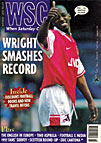 The art of photography at football grounds could be a dying art, says Tony Davis
The art of photography at football grounds could be a dying art, says Tony Davis
At a time when football is getting the most media coverage it has ever had, freelance photographers are finding it nigh on impossible to work at grounds thanks to restrictions placed by the big clubs.
There are two main problems. First is the difficulty of getting a press pass. A large percentage of the photography positions are now monopolized by the major photography agencies, and those left are often taken by the omnipotent Sky cameras for that vital one tracking shot of the linesman, or a slow motion replay on a corner seen from behind the goal.
More likely is that a request will be refused because the photographer, or their employer has not signed the binding Premiership agreement. In force for a couple of seasons now, this requires a commitment not to sell pictures of Premiership teams to any source that is not sanctioned, such as an unofficial club magazine. Legal action can be taken against the owners of the pictures if they appear elsewhere. Refusal to sign means forfeiting the chance of being accredited for a Premiership game.
Over the years many of the best and most durable football pictures have been produced by freelancers who were looking for something different from action shots. If the Premiership’s paranoia suceeds in driving away freelance photographers, the only images of football we’ll get to see will be the standard shots of 1990s corporate football – star players in their sponsored shirts, Shearer wheeling away after scoring and the witless choreographed goal celebrations of Dennis Wise and co.
Getting into the grounds isn’t the end of the problem, however. Then there are the stewards to deal with, most of whom are far more officious than the policemen they have replaced. Much stewarding work, particularly at clubs with a history of crowd trouble, is done by security firms, employing nightclub bouncers only too keen for an opportunity to get someone in an armlock and march them out of the ground.
Stewards are a particular problem for me because I take pictures of fans rather than action on the pitch. At my first match at Euro 96, I was threatened with being booted out of the tournament by a FIFA press official the moment I turned to focus on faces in the crowd. They even had someone watching my head movements from above to ensure that I was facing in the direction of the pitch, so I felt like a schoolkid ordered to face the wall and anticipating a thwack on the back of the head from teacher if I disobeyed.
The expectation of being frog marched out of a ground keeps you on your toes and I have developed a stock set of excuses to explain why I want to move away from the few square feet allocated to me. Recently a steward unearthed a dusty rule book and attempted to recite some arcane information about by-laws probably not changed since Elizabethan times. Neither of us were left any the wiser.
It’s ironic that clubs should have become so paranoid about pictures being taken of spectators at matches at a time when the crowds themselves are so placid – the days of clubs having to worry about fans being shown in a bad light by back page pictures of fighting in the stands have mostly long gone.There’s an added irony too. On the rare occasions when trouble does break out, at the Bristol derby last season, for example, the police are only too keen to call upon the help of photographers. Close up pictures of the chief culprits are likely to be much clearer than the blurred image produced by stills from a closed circuit camera.
From WSC 128 October 1997. What was happening this month